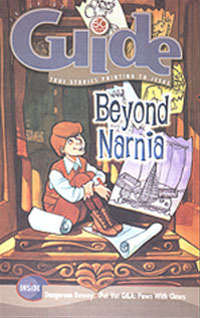His name just would not do. The strong-willed 4-year-old marched up to his mother, thumbed his chest, and said, “He is Jacksie.” From then on he was known by family members and friends as Jacksie, Jacks, or Jack.
Jack’s real name was Clive Staples Lewis, and he was born in northern Ireland in 1898. His father, Albert, was a lawyer, and his mother, Flora, was a homemaker.
Jack’s best friend was his older brother, Warren. The two brothers loved to ride bicycles, play chess, go swimming, and take care of their pets.
Warnie and Jack’s favorite time of the year was summer vacation, spent at the beach. The boys were accompanied by their mother and a nanny. Their father usually stayed behind to work.
The beach was so much fun! Warnie splashed in the waves, and Jack floated boats and pretended that he was catching fish. Mother would sit in the shade and write letters to Father, telling him about each day’s activities. As summer began to fade, the boys would help to pack up their things. Then came the exciting train ride home, with cities, stations, people, and farms seeming to fly by outside the windows.
Back home in Belfast, a terrible disease called tuberculosis swept across Ireland. Jack and Warren’s mother kept them inside during damp weather to help keep the boys from getting sick.
It rained a lot in Ireland, so the boys spent a lot of time indoors anyway in the early 1900s. Warren liked to paint pictures of ships. Jack started drawing animals who were dressed in clothes, like people. The animals soon had names, jobs, and personalities.
Jack introduced Warnie to the animal characters, and his older sibling started playing along. Soon their make-believe animals were having many rousing adventures. Jack and Warren dreamed up an imaginary country for them called Boxen. The Boxonians had many daring escapades, led by fearless King Bunny and General Quicksteppe. Jack and Warren continued to create fun stories about Boxen for the rest of their lives.
In 1905 the Lewis family moved to a new home named “Little Lea.” “Little Lea” was a large brick house nestled in a cluster of trees. The house was fun to explore. It had intriguing secret passages that the boys could crawl through. Warnie and Jack played in the huge attic, which was the perfect place to spread out their sketches and maps of Boxen. Jack wrote, “Soon there was a whole world and a map of that world which used every color in my paint box.”
Sometimes their cousin Claire came to visit. The children would climb into an old hand-carved wardrobe that had been made by their grand-father. The trio sat inside the large piece of furniture and told each other silly stories.
In May of that year, 10-year-old Warren was sent to live at a boarding school in England. In those days boarding schools were a very common way for children to get their education.
Although he missed his brother, Jack had fun by himself. He pedaled his bike a short distance from their neighborhood into the beautiful Irish countryside. He loved to ride over the narrow country roads, gazing at the green hills. Jack observed animals and farmers. He marveled at the beauty of God’s creation.
Jack also liked to read and write, and set up his own little office space in the attic. In a book he later wrote, Surprised by Joy, Jack recalled those days. “I had now learned both to read and to write; I had a dozen things to do.”
Jack wanted to make things, but they never seemed to turn out quite right, so he wrote stories instead. “You can do more with a castle in a story,” he wrote, “than with the best cardboard castle that ever stood on a nursery table.”
In 1908 Jack’s life changed forever. He was 9 years old at the time. Mother became very ill and died of cancer on August 23, which happened to be Father’s birthday.
Jack wrote that after his mother died, all of his happiness and feelings of security were gone. Shortly following his mother’s death, Jack’s uncle and grandfather both died too. Their father wasn’t very good at helping his sons through their sadness, and he buried himself in his work. A month later Jack was sent to boarding school.
Jack studied at three different boarding schools and with a private tutor named Professor Kirkpatrick. During his time at a school in Malvern, England, Jack began to doubt his Christian faith.
He decided that he did not believe in God at all, so he called himself an atheist. Jack reasoned that if there was a God, then the world would not be such a mess. No, there must not be a God.
Jack received a scholarship to University College in Oxford. Shortly thereafter, World War I broke out, and Jack enlisted in the British Army. After the war Jack returned to his studies at University College, and also became a teacher.
Jack began to rethink his views about God. He later realized that even though there were a lot of problems with the world, none of us would even be alive without the loving, sustaining protection of God. Jack understood that God is so full of life that He gave life to us.
One evening Jack had a long discussion with his friend, author J.R.R. Tolkien, and another friend, Hugo Dyson. Jack did a lot of thinking that evening.
The next day everything seemed to click. He became a Christian the following afternoon. In one of his books he wrote, “When we [he and Warren] set out [by motorcycle to the Whipsnade Zoo] I did not believe that Jesus Christ was the Son of God, and when we reached the zoo, I did.”
After Jack became a Christian, he wrote more than 30 books. Young people all over the globe love to read his fairy-tale series, The Chronicles of Narnia. Narnia is a magical world, accidentally discovered by four British children who enter Narnia through the back of a wardrobe. No doubt, Jack was stirred by his own childhood memories.
Even though Jack didn’t write the Narnia stories until he was around 50 years old, stories such as those about Boxen had thrived in his colorful imagination since he was a little boy. He loved children’s storybooks. Jack said, “When I was 10, I read fairy tales in secret, and would have been ashamed if I had been found doing so. Now that I am 50, I read them openly.”
During his lifetime Jack wrote hundreds of replies to letters from kids. He carefully answered their questions, praised the artwork that they sent to him, and encouraged them to write their own versions of Narnia tales.
Jack married a woman named Joy and became a stepfather to her two sons, David and Douglas. He continued his career of writing and teaching until his death on November 22, 1963 (the same day President John F. Kennedy was assassinated).
The books that he wrote can be found by the dozens in many libraries and Christian bookstores. But all the book covers display Jack’s real name: C. S. Lewis.
Illustrated by Ralph Butler


